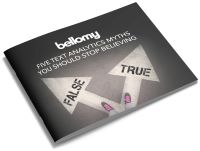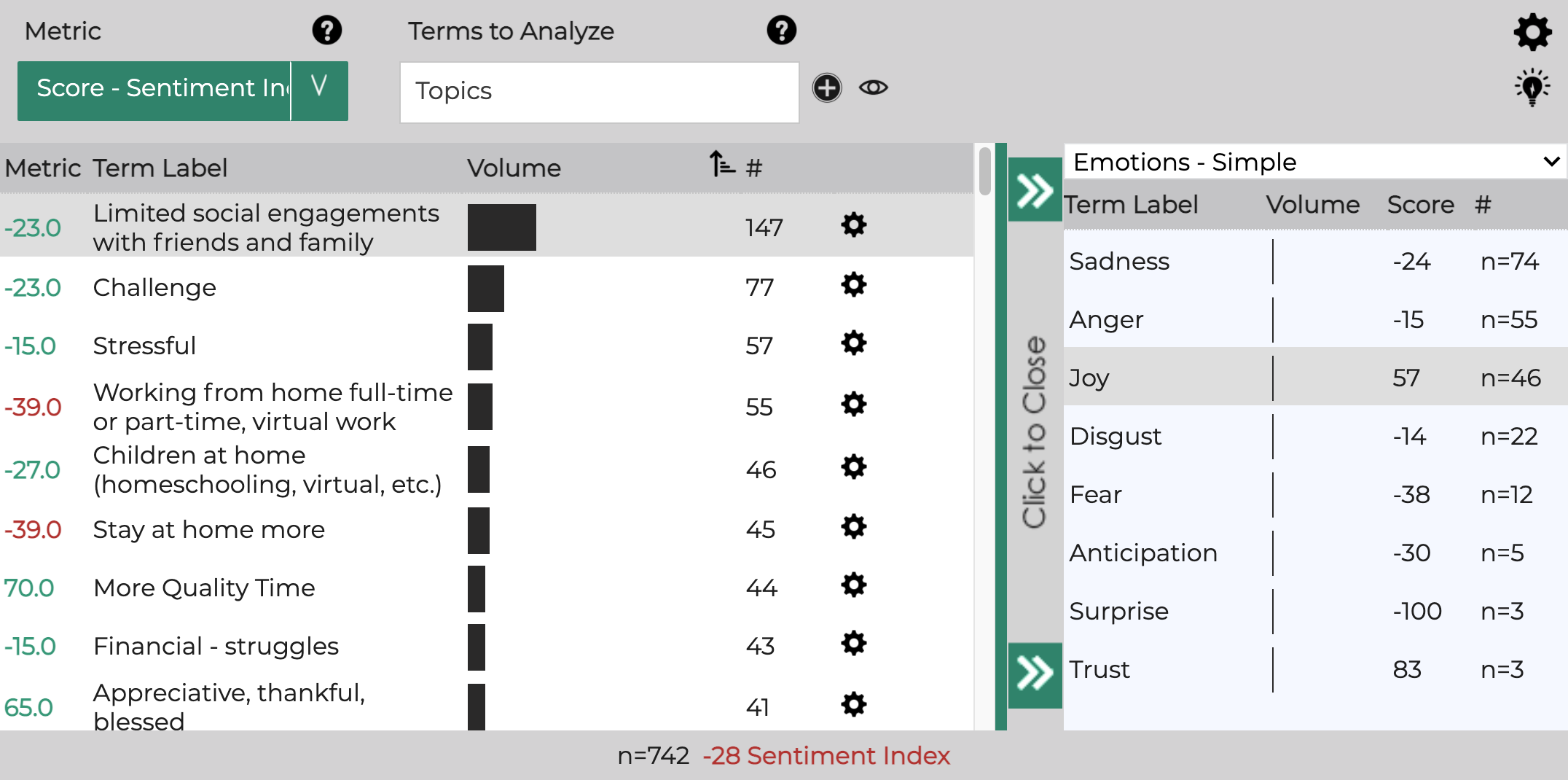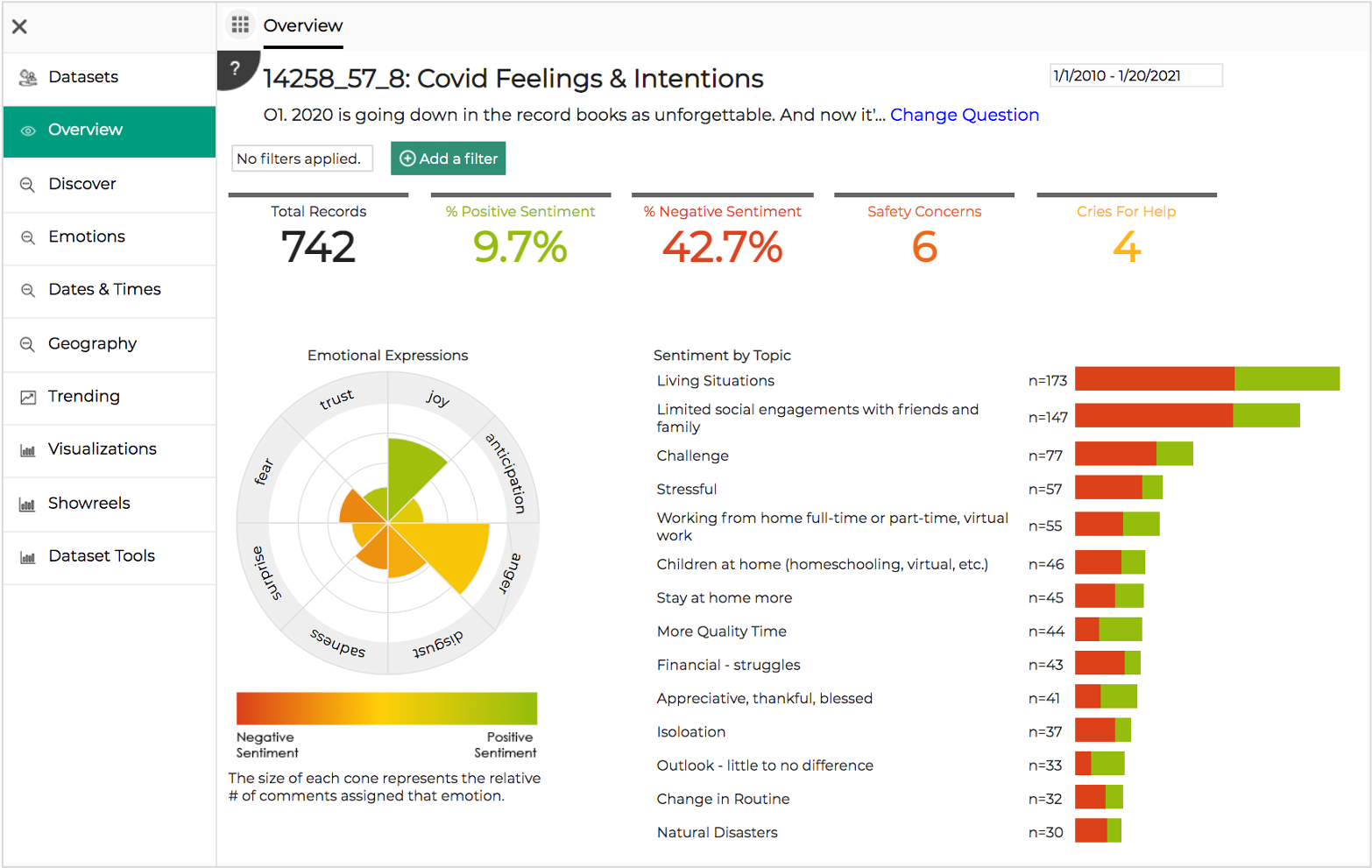Mining for new year mindsets
 Ask 742 people how they felt about 2020 and their outlook on 2021, and you’ll get 742 different answers. There are bound to be common themes, but each answer will have nuances and details that make it not only distinct but also valuable to understanding the current climate and mentalities of those experiencing it.
Ask 742 people how they felt about 2020 and their outlook on 2021, and you’ll get 742 different answers. There are bound to be common themes, but each answer will have nuances and details that make it not only distinct but also valuable to understanding the current climate and mentalities of those experiencing it.
Manually sifting through 742 open-ended responses is a cumbersome process. Instead, we brought the data into Bellomy’s Text Analytics platform and used our emotions AI, modeled after psychologist Robert Plutchik’s Wheel of Emotions, to examine the subtleties among these experiences.
2020 — no introduction necessary
2020 was an eventful year, to say the least. As we’re sure you know from your own social media feed, people have mixed responses to the hottest topics of the year... politics, vaccines, masks, working from home, and online learning. But when people were prompted to look back at 2020 as a whole, here’s what they mentioned most on their own.
 Unstructured data is complex and so are the tools used to analyze it. Make sure you’re not falling for one of these five common text analytics misconceptions — but here's what to do about it if you are.
Unstructured data is complex and so are the tools used to analyze it. Make sure you’re not falling for one of these five common text analytics misconceptions — but here's what to do about it if you are.
What was top of mind at the end of 2020
Your social life probably looks very different than it did at the start of 2020. "Limited social engagements with friends and family" was one of the most common topics among responses when asked to reflect back on 2020, with a sentiment index score (or average sentiment) of -23. This means that among the 147 reflections on 2020 that mentioned a change in social habits, more were classified as negative (-100 = max negative) rather than positive (100 = max positive).
Despite the negative impact that social distancing and isolation had on our 2020 memory bank, that average is still greater than the sentiment index score for all survey responses regarding 2020 (-28). A closer look at detected emotions could hint at why.

Out of the 147 responses that included some commentary on social engagement, almost one-third expressed joy in their response. This shows that while the overall sentiment toward changing social engagement was negative, some seemed to find a silver lining.
With five adult children living all over the state, it has been challenging! Two have purchased houses and moved and one got married. None of these events were as we wished they would have been. But we are thankful that all are well, employed, and thriving.
Stressful in worrying about job loss or loss of income. Also stressful in worrying about distancing from family and close friends and missing out on experiences with them. A silver lining has been spending more time together enjoying simple things at home and getting to know our neighbors better as no one has been going anywhere.
Zoom, zoom, zoom. Way less socializing & parties. Good for introspection. Harder to date & travel. Food prices have gone up. Appreciate the greater quiet & time with an older cat.
Plutchik's perspective: 2021 outlook
In text analytics, sentiment is unnuanced — a statement that contains five negative phrases and one positive is going to be marked as a negative sentiment (or mixed, at best). Sentiment often misses the nuances that are contained within a response.
Emotion is a far more intricate approach to analyzing how people are expressing themselves. An emotional model based on Plutchik’s theory of eight basic emotions (joy, sadness, trust, disgust, fear, anger, surprise, and anticipation) gives us a reliable framework for analyzing datasets. This is especially helpful when feelings are mixed and some degree of multiple emotions are expressed — as is the case when thinking about 2021.
Anticipation
Awaiting an expected event with pleasure or anxiety.
There’s no doubt that as the new year approached we were all ready to jump into 2021 and put 2020 behind us. Our research only further validated this notion. The text analytics tool recognized anticipation in almost 70% of responses about 2021. Despite all of the optimism about the thought of returning to normal, there’s still plenty of caution about being too hopeful.
I am looking forward to a somewhat return to normal, enjoying early retirement, and being able to do my volunteer work again.
I am cautiously optimistic, even though I know things won't be close to being back to normal until close to the end of next year. In the meantime, I will continue to work from home and the kids will continue to virtual school.
Joy
Feeling pleasure or happiness.
The release of a COVID-19 vaccine seemed to be the biggest driving factor behind respondents expressing joy. The thought of kids getting back into classrooms, restaurants reopening, and grandparents holding their grandchildren brings people pleasure, but that pleasure relies on the effectiveness of the vaccine.
Feeling hopeful about 2021 with the vaccine being out. Looking to business picking up and starting a side career. Looking forward to having more BBQ's and gatherings at my home. Looking for a feeling of normality and freedom.
I am taking a positive approach when it comes to 2021. While I'm fairly certain we all will still need to make some unpleasant decisions on with whom and where we spend time, I do plan to incorporate time with family and more expansive travel than in 2020.
Fear
A response to perceived danger, ultimately resulting in fleeing, hiding, or freezing from that threat.
While fear is the midline emotion, respondents can slide from apprehension to terror along that scale. The good news is, none of our respondents expressed terror when looking at what’s to come in 2021. Most have an apprehensive outlook on 2021 due to uncertainty surrounding the future.
I have hope that we will end COVID-19 but I am also realistic in that we probably won't.
I see more of the same as 2020, because the virus is still a major threat to all of us. I am very concerned about the future of everyone and everything.
A mixed bag of emotions
 Navigating emotions can be overwhelming as it is, and analyzing written survey responses (which don’t give you the contextual clues of verbal tone and body language) can make it even trickier. Applying a framework for identifying sentiments, emotions, and intensities gives us a quick way to identify and classify emotions within hundreds of verbatims. Modeling this framework within an automated system removes the human grunt work and makes a massive dent (usually around 90%) in assuring that responses are classified thoroughly and appropriately.
Navigating emotions can be overwhelming as it is, and analyzing written survey responses (which don’t give you the contextual clues of verbal tone and body language) can make it even trickier. Applying a framework for identifying sentiments, emotions, and intensities gives us a quick way to identify and classify emotions within hundreds of verbatims. Modeling this framework within an automated system removes the human grunt work and makes a massive dent (usually around 90%) in assuring that responses are classified thoroughly and appropriately.
If your market or customer experience research involves open-ended survey responses, Bellomy’s Text Analytics tool is an extremely efficient way to navigate and collect insights — maximizing the benefits of your research. Request a demo so that you can evaluate the platform yourself.

